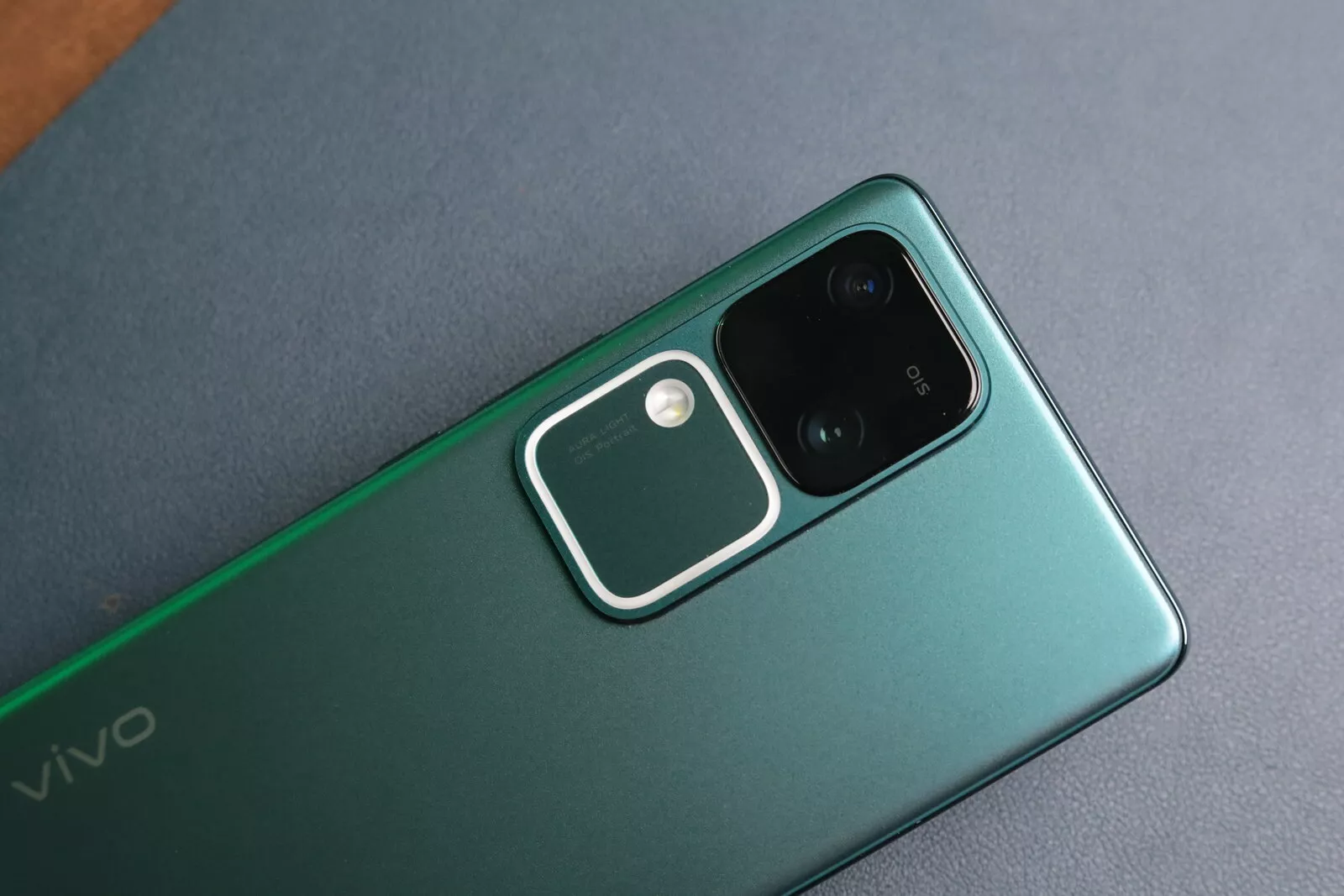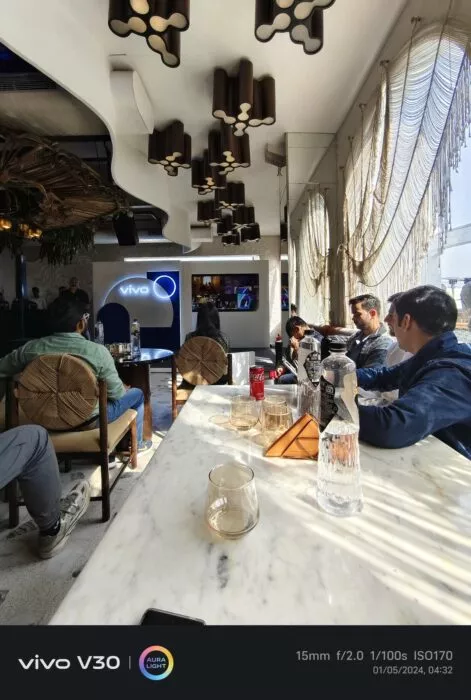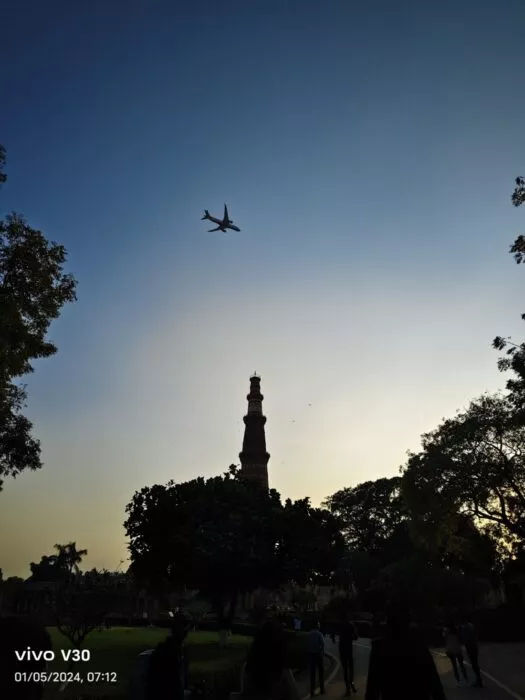vivo V30 Review: Sleek design, Amazing Camera!

It’s no secret that vivo has experienced a resurgence in recent years, thanks in part to the success of its flagship X series. However, the question now remains: has vivo also cracked the code for making a solid mid-range phone, or does its sister brand, iQOO, steal the spotlight? Let’s dive straight into the review of the all-new vivo V30.
vivo V30 Review
Summary
The vivo V30 is a great camera phone with a large vibrant display and excellent battery life. However, it struggles under heavy workloads and includes some weird software bugs.
vivo V30 Review: Design and Hardware

The design stands out as a pivotal aspect since vivo’s phones primarily target the offline market. The V29 series introduced a textured back, a feature carried over to the V30 series. The glass back, sporting a wave-like design, provides an aesthetically pleasing touch. However, since looks can be subjective, the phone is also available in black, green (with color-changing technology), and white variants.
The square camera module, notably smaller than its predecessor, houses a standard dual-camera setup with a primary and UltraWide camera (further discussed below). Additionally, the fact that vivo hasn’t stuffed any useless 2MP macro cameras makes the device look sleek. Moreover, the company has another trick up its sleeve, i.e., the Aura Light. The feature, introduced with the V29 series, serves as an enhanced flashlight for low-light photography.


Moving over to the sides, the device boasts a plastic frame with underlying aluminum rails, as stated by vivo. Despite the premium look and feel, it’s essential to note that the shiny plastic is prone to scratches. As a result, users are advised to use the included case for added protection.
Furthermore, the vivo V30 series boasts IP54 dust and splash resistance, offering protection against rain and minor water spills.
vivo V30 Review: Display

Both the vivo V30 and V30 Pro boast the same 6.78-inch 1.5K 120Hz curved AMOLED display, with a peak brightness of 2800 nits. However, during our testing, the device showcased a lackluster performance in direct sunlight. This discrepancy arises because vivo’s claimed 2800 nits peak brightness is exclusively applicable when viewing HDR content. As a result, outdoor visibility is not very enjoyable, thus requiring users to either squint a little
In addition to the lack of brightness, we observed a noticeable red tint when watching non-HDR videos, where the faces would look significantly artificial. And although all phones aren’t perfect in reproducing colors, the vivo V30 deviates from them a lot.
Fingerprint sensor and durability
The front houses an optical fingerprint scanner that performed well in various scenarios during our testing. However, the placement of the scanner slightly deviates from where the thumb naturally rests, a minor inconvenience worth noting.
In terms of durability, the phone relies on Schott Alpha glass protection, which, unfortunately, did not hold up well in our two-week testing period, as it incurred a deep scratch. However, this shouldn’t be a problem if you use a screen protector.
Confusing refresh rate settings

The vivo V30 offers three display refresh rate settings: smart switch, 60Hz, and 120Hz. Considering that running the phone on 120Hz will drain a significant amount of battery, the smart switch option seems better since it automatically switches between refresh rates, at least in theory. Unfortunately, this is not the case, as the feature locks the refresh rate at 90Hz, only boosting to 120Hz in specific apps like the gallery.
As a result, to experience a consistently fluid performance, users must manually set the refresh rate to 120Hz. However, the fact that the 120Hz setting automatically changes the refresh rate based on the content renders the smart switch option redundant and impractical.
vivo V30 Review: Performance and Battery

Powering the vivo V30 is the mid-range Qualcomm Snapdragon 7 Gen 3 chip, along with the Adreno 720 GPU. Additionally, the device boasts up to 12GB of LPDDR4X RAM and 512GB of UFS 2.2 internal storage.
Starting with synthetic benchmarks, the phone scored 1158 in Geekbench’s single-core test and 3187 in the multi-core test, aligning it with other devices housing the same chipset. Additionally, in the Antutu test, the phone scored 791,841 points.



During everyday use, the phone showcased smooth performance for tasks like scrolling through social media or watching 4K YouTube videos. However, in more demanding scenarios, such as opening or closing the camera app or games, we did experience stuttering. Such issues can be attributed to the slow storage. However, we experienced some major lagging and jittering issues when playing 4K HDR content on YouTube. This issue forced us to adjust the resolution to enjoy our preferred content manually. While this might be a software glitch or maybe a review unit-specific once because we have been testing the phone 2 weeks before the launch, it should be fixed before the phone goes into public hands
Talking about gaming, while the phone doesn’t support 90Hz in games like BGMI or COD Mobile, you can play these games at the maximum settings. Additionally, thanks in part to the new vapor chamber cooling system, the phone did maintain its temperature and didn’t overheat.

However, we experienced some major lagging and jittering issues when playing 4K HDR content on YouTube. This issue forced us to manually adjust the resolution to enjoy our preferred content. While this might be a software glitch, it’s crucial to emphasize that the vivo V30, as an upper-midrange phone, should ideally not encounter video playback issues.
Amazing battery life

vivo claims that the V30 is the slimmest phone housing a 5,000mAh battery, and our hands-on experience validates this claim. During heavy testing involving gaming, photography, and video consumption, the phone seamlessly went through a full day of heavy usage. Additionally, the device ships with an 80W charger, capable of recharging the battery in 35-40 minutes.
vivo V30 Review: Cameras
Cameras have always been vivo’s strength, and we can confirm the same is true for the V30. However, to put things into perspective, the vivo V30 features a 50MP f/1.8 main camera sensor and an additional 50MP 119-degree UltraWide sensor.






The photos pleasantly surprised us from the main camera, as they were aesthetically pleasing while maintaining exceptional dynamic range, sharpness, and vibrant colors. The inclusion of three color profiles—vivid, textured, and natural—offers users the flexibility to tailor color reproduction to their preferences.
In our testing, the natural profile delivered balanced photos, while the textured mode leaned towards aggressive HDR, creating a somewhat edited appearance. Notably, the vivid mode emerged as the standout, producing stunning daytime photos.



Given the absence of a dedicated telephoto sensor, the main camera also takes up the role of a portrait lens. The resulting portraits showcase outstanding edge detection and skin tone accuracy, thus somewhat justifying the “Professional Portrait” branding on the device.






While daylight photography presented no issues, we encountered a smudging problem during harsh sunlight captures attributed to HDR processing. Nevertheless, this could easily be fixed via a software update.
Nighttime photos
Capturing photos in artificial lighting yielded satisfactory results, with the phone preserving details while keeping noise to a minimum. However, when photographing human subjects, there was a slight compromise in detail as the phone attempted to reduce noise. However, the overall performance aligns with other contenders in this price segment.





UltraWide photos and Selfies
The 50MP sensor contributes to the UltraWide camera’s ability to match the main camera in detail, delivering photos with impressive HDR and vibrant colors. Despite some subtle color variations between the main and UltraWide sensors, the UltraWide camera performs well even in nighttime conditions.



On the selfie front, the 32MP shooter excels, capturing stunning photos with pleasing skin tones. The wide sensor makes it an ideal choice for group selfies.



Aura light
Introduced with the V29 series, the Aura Light flash system aimed to enhance flash quality for improved low-light photography. While its implementation fell short initially, the V30 appears to have addressed these issues. The feature produces aesthetic photos and allows users to even customize the color temperature of the light.



Videos
In the mid-range price segments, it’s no surprise that almost every phone struggles with videos. However, the V30 surprised us with its video capabilities as well. The output consistently exhibits well-lit, detailed, and stable footage. Moreover, the inclusion of 4K video recording support for the front camera is amazing, especially when compared to the company’s flagship X100, which tops out at 1080p video.
vivo V30 Review: Software and Speakers

Fortunately, the V30 comes with Android 14 and the company’s FunTouch OS 14. While vivo’s interface diverges from stock Android, it offers a plethora of features. Most notably, its customization options allow users to personalize fingerprint animations, lock screens, and more, thus enabling users to make their phones unique. Additionally, the UI feels fluid with great animations.
Furthermore, despite the presence of some pre-installed applications, the bloatware situation has improved, with no inclusion of useless apps. However, it is important to note that the browser sends a lot of unnecessary notifications.
Unfortunately, the cost-cutting is evident in the speaker department. The V30 retains a bottom-firing mono speaker similar to its predecessor. Although the sound quality is good, the speaker is easily obstructed by hands.
Is the vivo V30 Worth It?

Starting at 33,999 INR for the 8GB +128GB variant, the vivo V30 competes directly with the iQOO Neo 9 Pro, which has a much better processor. However, if your main focus is the camera and your workflow isn’t demanding, the vivo V30 could be a good option. The phone is currently available for pre-booking and is scheduled to go on sale starting March 14th.






